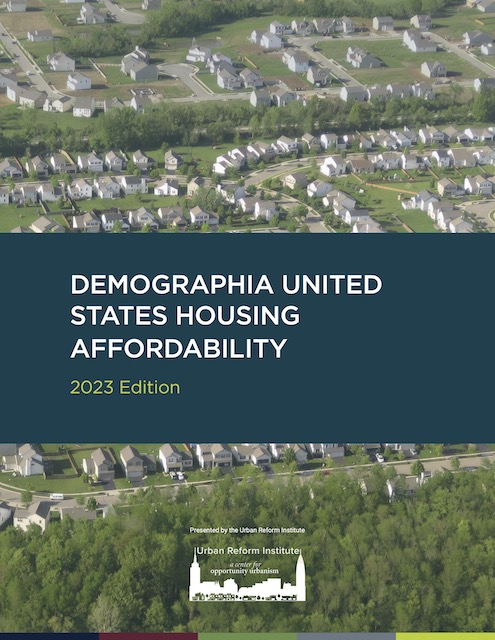Due to the large number of people seeking to move during and after the pandemic, the number of severely unaffordable housing markets quintupled between 2019 and 2022, says a new report from demographer Wendell Cox that traces the changes in housing affordability in 174 major U.S. housing markets. Of those 174, Cox classified 44 as affordable in 2019, but only 11 were still affordable in 2022. The good news is that’s a slight improvement over 2021, when only 9 were affordable.
 Click image to download a 3.1-MB PDF of this 28-page report.
Click image to download a 3.1-MB PDF of this 28-page report.
Cox measures affordability by comparing median home prices with median household incomes. This is slightly different from the Antiplanner’s comparison of median home prices with median family incomes. Both of us consider housing to be affordable when median prices are less than three times median incomes and severely unaffordable when median prices are more than five times median incomes.
Since at least 2013, Cox has published an annual review of international housing affordability that mainly looks at the English-speaking world. About 44 U.S. housing markets were in the latest international review; the report released this week expands this to 174 U.S. housing markets.
Prior to the pandemic, differences in housing affordability were mainly due to differences in rural land-use regulation. Single-family zoning in cities had zero effect on housing affordability: Dallas and Houston have been roughly equal in affordability for decades even though Dallas has single-family zoning and Houston does not. But regions with strict rural regulation, including Seattle, Portland, the San Francisco Bay Area, Los Angeles, and Honolulu all have marginally or severely unaffordable housing.
The pandemic, however, impacted affordability everywhere. On one hand, millions of people wanted to move to places that they perceived to be safer or having higher quality of life. On the other hand, labor shortages and supply-chain problems made it difficult for homebuilders to meet the demand for new homes that resulted from pandemic-related migration.
All of the urban areas that Cox ranks as affordable have fewer than half a million people and all but three are in the Midwest — the other three are Utica, New York and Erie and Scranton, Pennsylvania. But the first urban area in the moderately unaffordable category, with a price-to-income ratio of 3.1, has a population is more than 1.7 million: Pittsburgh. It is affordable because, like Erie and Scranton, it is in the heart of the rust belt.
Atlanta, Dallas, and Houston have historically been the nation’s fastest-growing urban areas because they have been among the most affordable. But the pandemic demand shock, as Cox calls it, has pushed them into what Cox calls the seriously unaffordable class, with price-to-income ratios between 4.5 and 4.9. I suspect that their affordability will bounce back, while places like San Francisco and Los Angeles have remained severely unaffordable (price-to-income ratios greater than 10!) even though they have become undesirable places to live due to both high housing prices and general lawlessness.
Supply-chain problems and labor shortages should work themselves out. Problems with rural land-use regulation can only be fixed by repealing those laws and regulations.








Amaericas housing shortage is more simple. Stop building McMansions and go after zoning.
It’s time to legalize building starter homes again by reforming regulations like parking mandates, setback mandates, minimum lot size mandates, and unit size mandates, all of which make this development style virtually impossible to build in most places.
Cape Cods, Ranchers, Bungalows, shotguns and duplexes were built for decades . They are extinct….
What does zoning and any of the things you listed have anything to do with starter homes? Seems like you’re just parroting things you read on Twitter.
Modern suburbs no longer uses blocks, thus uses cul de sacs with huge distances between blocks. This extends the “Distance” even people walking need long route. The HALLMARK of modern car dependent suburbia is modern zoning laws; is residential areas are completely separated from commercial uses thus every trip is longer regardless walk or not, and most dont. Even the boundaries between the two, separated by Stroads, Uncomfortable or DANGEROUS places to be Outside of a car. Even schools are not permitted either. So the major building is consolidated to a arterial road, Roads too dangerous for children to walk along. REQUIRE be driven to school. Strict zoning requirements, means most suburban houses are built the same. At similar price point.
Older suburbs houses are closer up to the street. In modern suburbia, setbacks require houses be 10-20 meters because…some 1950’s urban designer decided having a Huge front yard, is “Ideal” way to live so blearggh.
Incidentally the pressure on developers to build as Many houses as possible on the fucked up spiralling plan, combined with strict setback requirements is why you’ll often see new suburban houses with backyards Way smaller than front yard, Both of which are now useless.
Crossing the street shouldn’t be deadly….But it is.
A four year old in Japan has more independence and Freedom than a fifteen year old in America.
https://www.npr.org/sections/goatsandsoda/2022/04/20/1093153651/a-4-year-old-can-run-errands-alone-and-not-just-on-reality-tv
Since WWII, regulations have piled up across North America that prevent small, starter homes from being built and squeeze out small, local developers in the process.
https://archive.ph/i0GnX#selection-1197.5-1197.92
In 1998, minimum lot size rules in Houston’s inner city beltway were reduced from 5,000 square feet to 1,400 square feet, then in 2013 the reform expanded throughout the city.
This is what our neighborhoods can look like when we reform local zoning regulations.
https://pbs.twimg.com/media/F48niUBWIAAj4tx?format=jpg&name=small
LazyReader, but where will people park??? Think of the cars, they are the most important thing!!
Looking through the listings in my town, I noticed all the older homes on the markket have been ‘flipped’. They now feature new fixtures, spiffy bathrooms, engineered hardwood floors, stainless built-in appliances and granite countertops. All of these things make the homes more expensive; none of these things make them any better place to live.